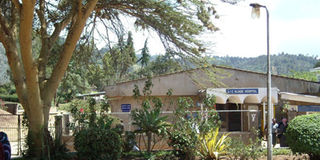Town sells no alcohol, no cigarettes

AIC Kijabe Mission Hospital in Kijabe Town. The town remains the utmost centre of Christian faith with no alcohol or cigarettes being sold. Elwood Davis and his wife, Bernice Conger, a nurse, arrived in Kijabe in 1920 to work at the Theodora Hospital. PHOTO|FILE.
What you need to know:
- The town remains the utmost centre of Christian faith — a citadel of purity.
- Hulburt’s first task was to build a hospital.
- In their early days, the missionaries found themselves at loggerheads with the Kikuyu Central Association (KCA) supporters, who opposed the rise of the mission stations and warned locals not to associate with their work.
- It still has no bar after 110 years of its foundation.
Kijabe is the only town in Kenya where you cannot purchase cigarettes or alcohol.
Even with its population of 5,000, it has no bar and nobody is allowed to smoke.
The town remains the utmost centre of Christian faith — a citadel of purity.
Again, Kijabe might be the only town in Kenya whose economy is centred around mission work.
Any investor in the town has to sign an agreement with the mission that they would not sell alcohol or open entertainment joints.
It all has to do with the history of this small town on the hill
The rise of Kijabe is credited to American missionary Charles Hulburt, whose vision was to extend the African Inland Mission (AIM) to “all directions” from Kijabe after he moved his headquarters there from Kangundo.
Initially, though, Hulburt was not interested in the town.
Lord Delamere
He wanted to have his mission on the shores of Lake Naivasha, where one day in 1903, he marked the land to obtain for his mission work.
But since it was a late afternoon, the colonial administrator could not sign the lease. He was asked to come the following day.
Unbeknown to Hulburt, Lord Delamere was also in Naivasha looking for land.
That evening after a couple of beers, the colonial administrator told Lord Delamere about the missionaries’ interests.
Delamere thought that the land was so prime that it could not “be wasted on missionaries.”
The colonial administrator agreed and when Hulburt arrived the next day, Lord Delamere had the lease of what is today the Delamere Soysambu Farm.
Hulburt was asked to take up a spot in Kijabe, where at 7,200ft, it was malaria-free, cool, and near the railway. But there were many wild animals.
Build hospital
Hulburt’s first task was to build a hospital. He was a friend of US President, Theodore Roosevelt, and so he named the new hospital in Kijabe, Theodora Hospital in Roosevelt’s honour.
It was Hulburt who invited Roosevelt to Kenya in 1909 to lay the foundation of the nearby Rift Valley Academy, which was built for the children of the missionaries.
Roosevelt had left the White House in March and on August 4, 1909, he laid the stone that is in the Kiambogo building of the academy.
Kiambogo is the original name of Kijabe. It means “the hill of cape buffaloes”, which roamed the area. The beast is still the school’s mascot.
In his book, African Game Trails, Roosevelt talked glowingly of Kijabe’s American Industrial Mission (as he called it).
“Industrial teaching must go hand in hand with moral teaching… Kijabe will be an indispensable factor in the slow uplifting of the (locals).”
The growth of Kijabe to become one of the largest mission stations in Africa took a good turn when Indian shopkeepers followed the missionaries and set up shops near the railway station.
Kijabe was famous. Letters to the missionaries were only written “Kijabe via Mombasa”, and a local named Karanja Kago would collect them from the railway station.
Among other missionaries who followed Hulburt were Elwood Davis and his wife, Bernice Conger, a nurse who had graduated from Hahnemann College of Medicine in Philadelphia.
Africa Inland Mission
The couple sailed to Africa under the banner of the Africa Inland Mission. They arrived in Kijabe in 1920 to work at the Theodora Hospital. Davis had a reputation as a skilled surgeon.
He made the hospital famous.
But in their early days, the missionaries found themselves at loggerheads with the Kikuyu Central Association (KCA) supporters, who opposed the rise of the mission stations and warned locals not to associate with their work.
This caused the church attendance to drop from 700 to 30 in the 1920s, while the number of girls in Kijabe Girls School reduced from 300 to 80.
The bone of contention concerned female circumcision.
The missionaries overcame the hiccup and Kijabe has continued to expand, living up to its reputation of purity.
It still has no bar after 110 years of its foundation.





